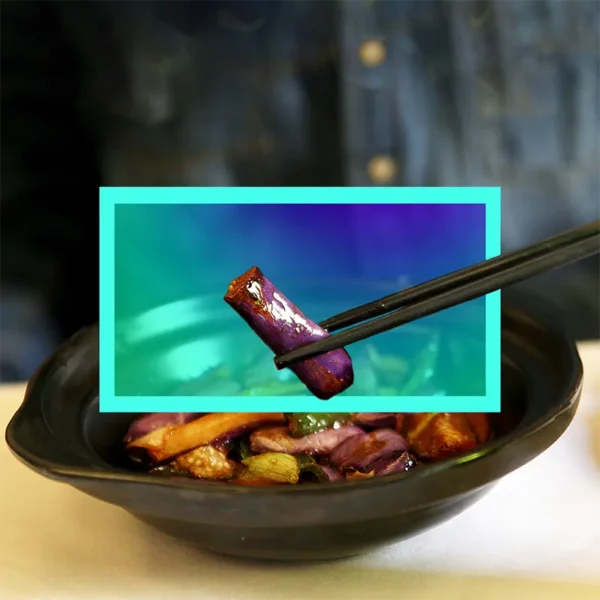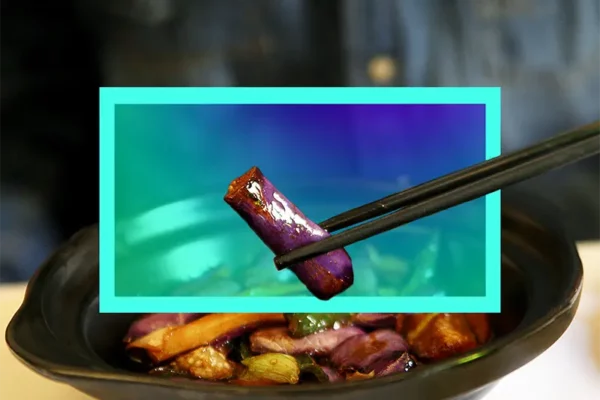ROHAN GUNATILLAKE: I guess you might call it eggplant, but I call it aubergine. Sorry everyone in North America and Australia.
To be more specific, what I’m actually talking about is yuxiang qiezi. Sorry everyone in China for my horrible pronunciation.
I didn’t mean to start off by annoying a decent percentage of the world’s population, but hey. This is the latest in the series of my own personal stories that pop up on your favorite podcast feed every few weeks. And this time it’s about food.
Is it about food? Or is it about creativity? Or is it about what happens when you do the same thing again and again – and how that can open things up? When you let go of the recipe and just let your instinct take over. Let’s find out.
Last year I made the same dish for dinner every week for me and my wife for nine months in a row. Give or take.
Back in March 2020 and the first lockdown here in the UK, my daughter Sophia was just one and a bit and not sleeping particularly well. So I’d often be in her room, settling her or just sleeping on the spare bed there, so Lucy could get some proper sleep. It was a tough time for a lot of reasons.
It was also the time I got into Chinese cooking videos on YouTube. And when I say got into them, I mean got into them.
I’ve always loved Chinese cooking. When I was very young, my family spent two-and-a-half years in Hong Kong and so when we came back to the UK, my father’s love of Cantonese food came with us, and he would often make some of the favorite things he’d picked up while out there. I think he’d even gone on a cooking course or two.
Now I like Cantonese food. I appreciate the relatively simple flavor profiles, and it makes sense why this is what has spread so much around the world.
I like Cantonese food, but I love Szechuan food. I guess it’s because it’s just so unashamedly spicy but subtle at the same time. One of the good things about living in Glasgow, Scotland is that there is a well established ethnically Chinese population boosted by the growth in Chinese university students in recent years. And so when I’m picking something from a restaurant for take-away, there is always that bit of the menu which is really for Chinese people. I remember in London how it would always only be written in Mandarin characters, but thank goodness in Glasgow it’s most often in English too.
And the dish I love getting the most is called yuxiang qiezi (again, apologies), which translates as fish fragrant aubergine. The fish fragrance bit of it is yuxiang, and there are two things you should know about it. First, that it’s a general flavor profile (you can get yuxiang other stuff), and secondly that there’s no fish in it. Long story.
It’s past 2 a.m. in the morning. The only light in the room is from an illuminated clock, a lit blue face with a star. Sophia is asleep in my arms having just been settled, again. And I lean back on the bed, and I realize that all I want to be doing is learning how to cook fish fragrant aubergine. Mainly because I have no idea how. And also mainly because along with Sri Lankan string hoppers, it is – when served with some good white rice – probably my favorite food of all time.
I watch about seven different videos. And they’re great. One of them is from the outrageously good channel “Chinese Cooking Demystified,” which becomes a total obsession. But they all involve deep frying the aubergine, which I get is the traditional way of doing things, but I’m just not that down with it. That’s when I discover Andong.
Andong is a German food Youtuber who lives in Berlin but studied in China, so many of his videos are about Chinese classics, many of them Szechuan-inspired. He’s very charming, passionate, and fun. And being a professional video producer all means that his stuff is just so good.
But here’s the thing. In his yuxiang qiezi video, he steams the aubergine and doesn’t fry it. Sophia buzzes a snore and doesn’t realize how mind-blowing this is. I’m quite tired.
I’m tired, but the next day, I make the recipe for dinner. The kids are in bed and I cook while Lucy and I reconnect after a busy day. We then go and watch whatever show we’re into at the time.
Oh but the food. It’s good. I’ve had to get two ingredients I’ve never used before: doubanjan and chinkiang, fermented chili bean paste and black vinegar. They’ve now become staples.
My first attempt at yuxiang qiezi. I love it, and Lucy loves it. It becomes a ritual. Literally every Wednesday evening from then for the best part of a year, I make it. Again and again. And, again and again. In that time, I move away from Chinese cooking videos to rap reaction videos. Sophia starts sleeping much better. Homeschooling starts and then mercifully ends. Variants arise. But what stays the same is that I’m making “the aubergine thing.”
It’s actually quite an easy dish to make. First you salt and then cook the aubergine somehow. Steaming, frying, grilling is good too. Then you fry up some garlic and ginger with the chili bean paste. Adding pork mince is a classic move here too. Then chuck the aubergine back in and put in the sauce, which is a mix of soya sauce, cooking wine, sugar, black vinegar, and stock. Thicken with a bit of cornflour, and finish with some chopped scallion greens for a burst of color. Spicy, sweet, jammy, meaty aubergine with big umami vibes and a vinegar zing. It’s got the lot. It’s pretty much perfect. It is perfect.
I make it again and again, and we never get bored. Then after two months or so, I start changing things. Switching the pork mince for chicken, for turkey, for beef, for lamb, for venison, for homemade seitan mince for a vegan kick. I start pairing it with sides, always fresh and crunchy. Pak choi salad. Pickled cucumber. Classic shredded potatoes. I start switching other things. Balsamic vinegar and adding peppers makes it more of a ratatouille. But I soon home in on what is the best combination. Classic pork or minced chicken. Grilled aubergine and always a green side. Thai fragrant rice. Always make too much so there is enough for fried rice the next day. But there’s rarely any aubergine left over no matter how much I make. Funny that.
Then at some point I stop using the recipe and just do it by feel. And I think that’s when it becomes the best version of itself. Now it’s at the point where I would have to really think about it to write the recipe down for how I make it since I’ve let go of measurement and guides. I think it’s a kind of mastery.
And that’s the idea I want you to take away from me this week.
Part of what we’re doing with this show is sharing recipes for mindfulness in your life. Different combinations hooked to wonderful stories, all with an invitation to try them out and see what you connect with. And practicing again and again is an ingredient of success. But what I’ve found most important to me, what has helped me reach the peaks be it around the wok or in my practice, is to know the recipes so well the only way to progress is to move beyond them and make them your own. Drop them, not too soon, but do drop them.
And yes I will leave some links to the recipe videos I mentioned here. They’re worth checking out if the aubergine thing sounds like your kind of thing, it works just as well vegan or vegetarian by the way.
Thank you Andong from “My Name is Andong.”
Thank you Fuschia Dunlop, the OG Western writer on Szechuan food.
Thank you Chris and Stephanie from Chinese Cooking Demystified.
And thank you.
Eat well.






